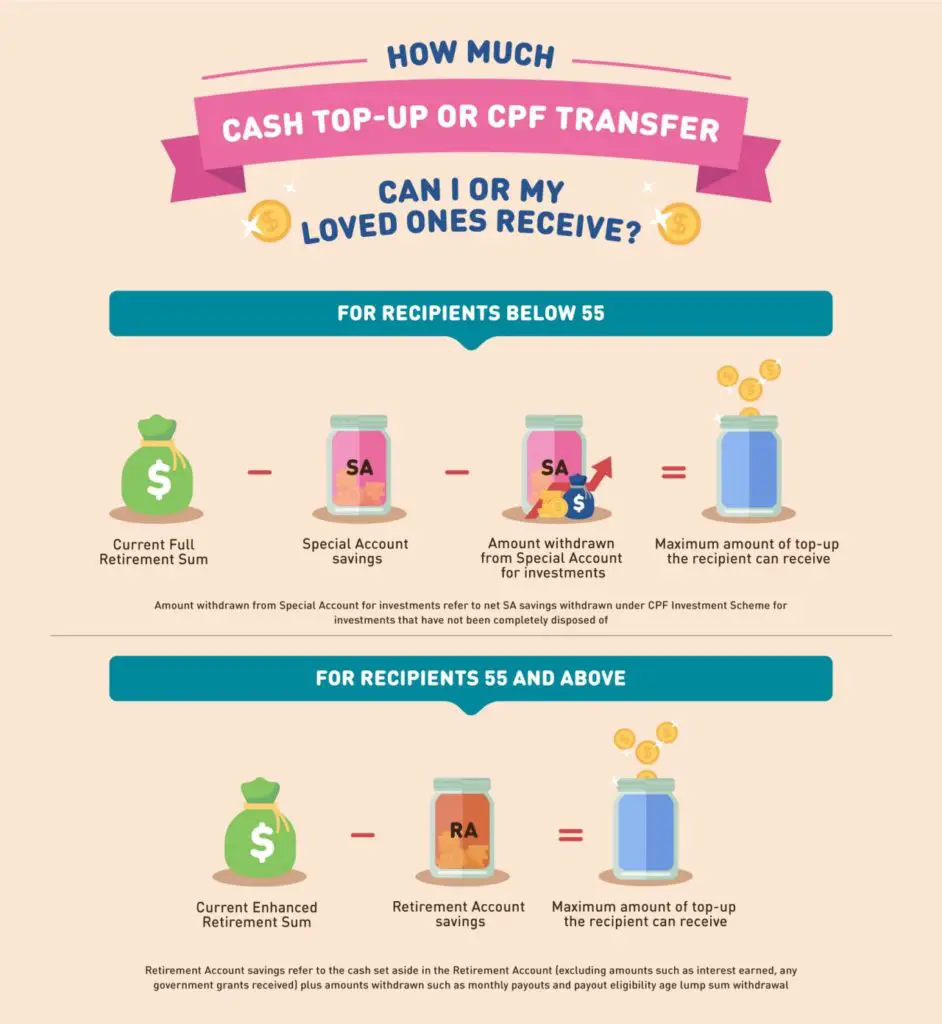You’ve decided to transfer some of your CPF Ordinary Account (OA) funds to your Special Account (SA) to earn higher interest. However, you may have doubts about how or when to do so. This guide will provide you with all the information you need to dispel any questions and also suggest strategies on how best to do it.
Contents
- 1 Can I transfer from my CPF OA to SA?
- 2 How do I transfer from my CPF OA to SA?
- 3 Can I transfer from my CPF OA to my spouse’s SA?
- 4 What is the limit to transfer from my OA to SA?
- 5 What is the best time to transfer from my OA to SA?
- 6 Do I get tax relief if I transfer from my OA to SA?
- 7 What are the benefits of transferring from my OA to SA?
- 8 Conclusion
Can I transfer from my CPF OA to SA?
You can transfer funds from your CPF Ordinary Account (OA) to your Special Account (SA) under the Retirement Sum Top Up (RSTU) Scheme if you are:
- Below age 55, and
- Your combined SA and savings withdrawn from SA under the CPF Investment Scheme (CPFIS) is less than the current Full Retirement Sum (FRS)
If you are aged 55 or above, you can consider topping up your Retirement Account (RA) instead to earn a higher interest on your CPF balances.
You can top your RA up to the prevailing Enhanced Retirement Sum (ERS)!
How do I transfer from my CPF OA to SA?
You can transfer your CPF Ordinary Account (OA) funds easily to your Special Account (SA) either through the CPF Website or the CPF Mobile App. Here are the steps to carry it out:
#1 CPF Website
1. After logging into your CPF account using your SingPass, click on “Tools and Services” at the top of the webpage:
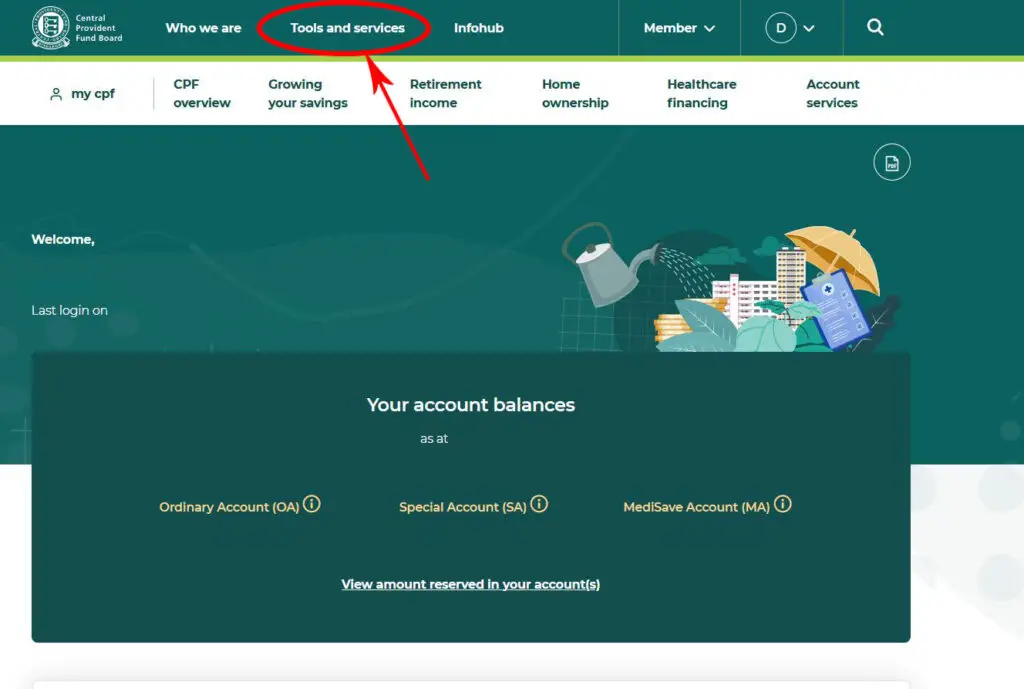
2. Next, under “Forms and e-applications”, select “View Forms”.
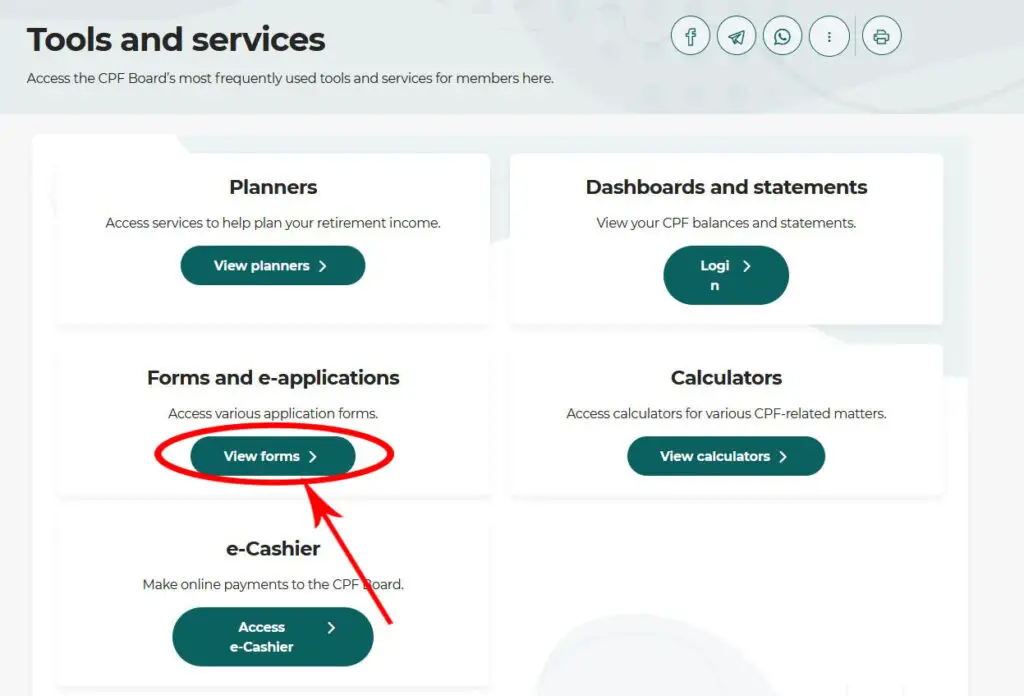
3. Select the first option under “Growing your Savings”, “Save more with CPF”. Under the drop-down menu, click on “Apply Online” under the first section “Cash top-ups and CPF transfers for retirement”.
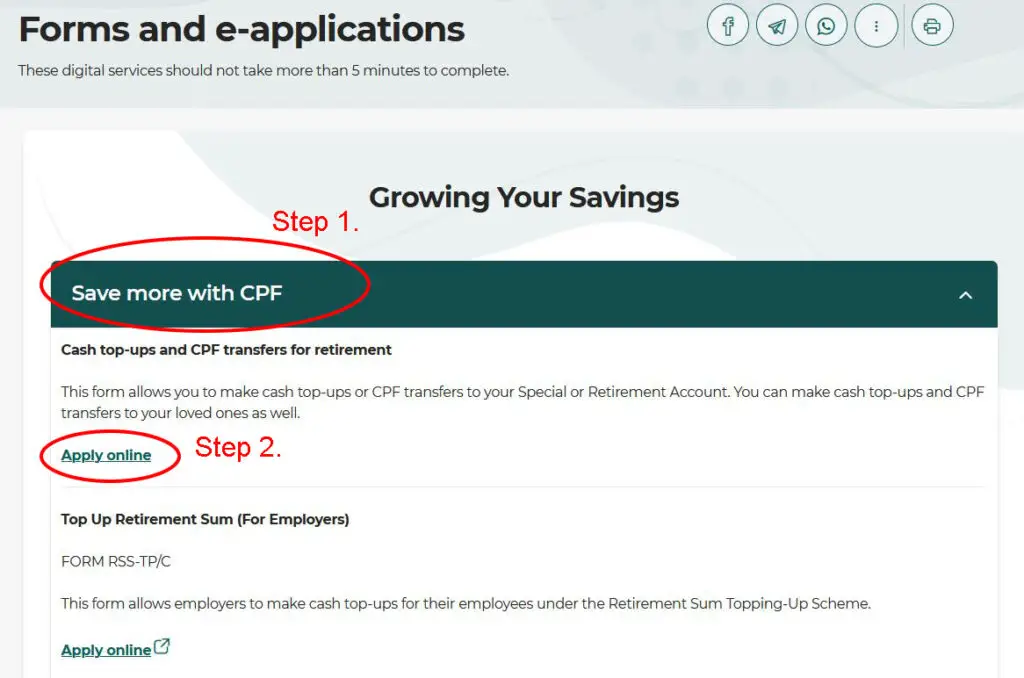
4. Check the “I have read and accepted the Disclaimer” checkbox to start the top-up process.
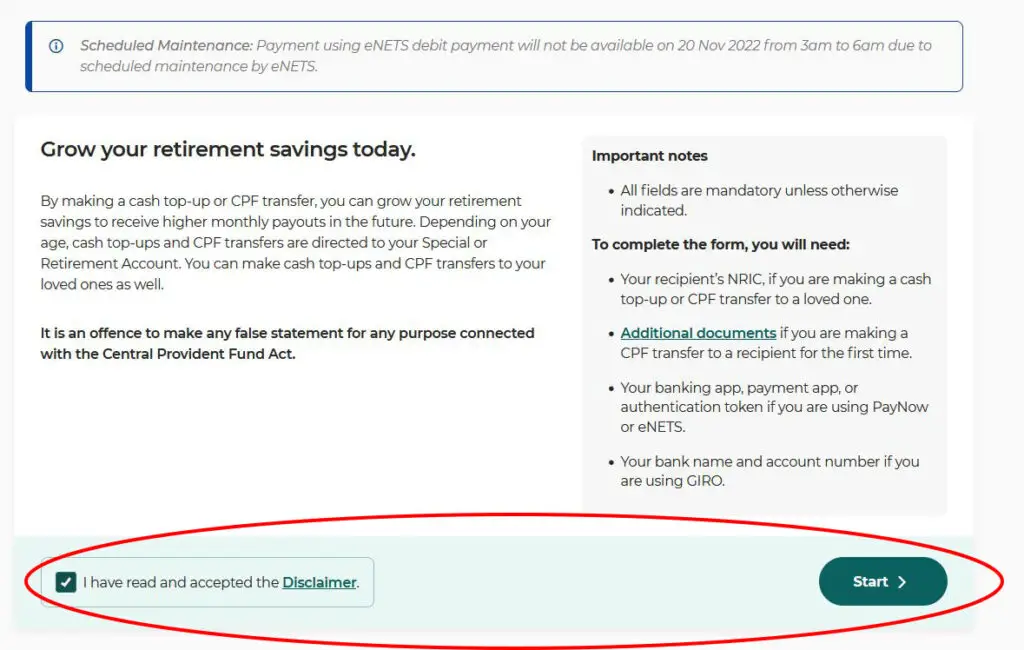
5. Under the options available, select “CPF transfer”.
You may want to note that CPF transfers are not eligible for tax relief and matching grants by the government.
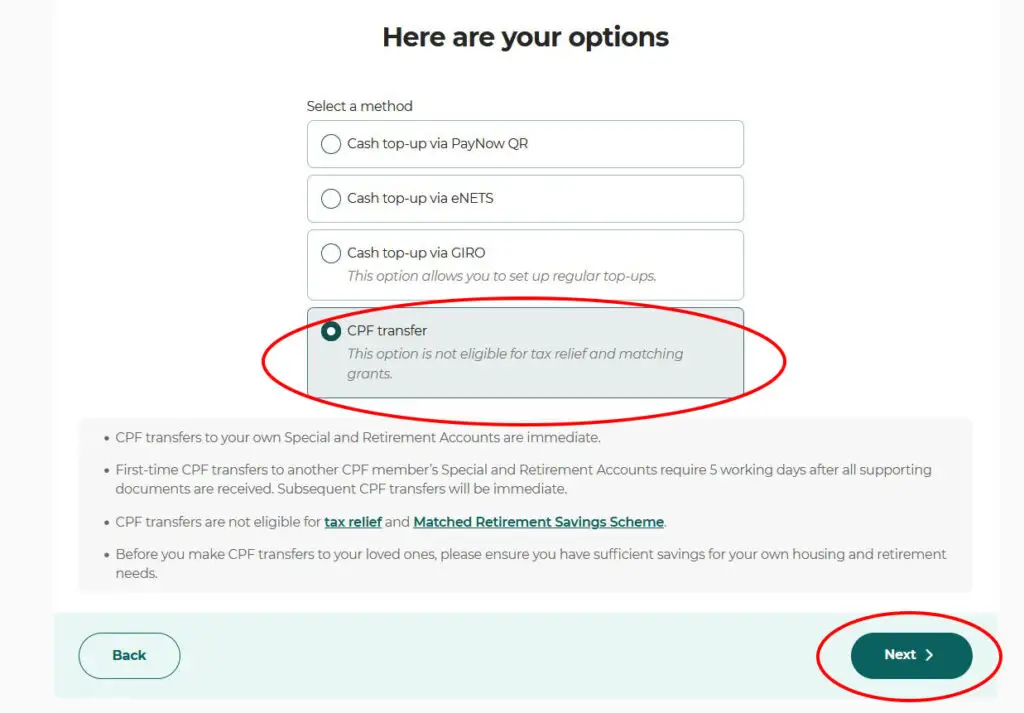
6. Under “Recipient Details”, select “Myself”. You will then be prompted to enter the amount that you want to transfer to your SA. Scrolling down, confirm your contact details and fill in some feedback, before going to the next step.
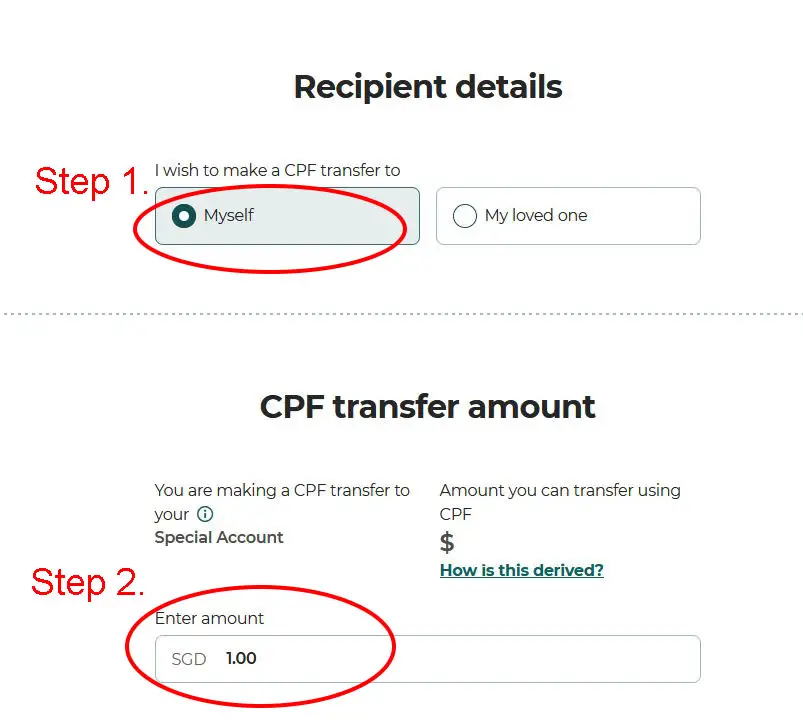

7. You will then be asked to review your application. Once you have confirmed the details are correct, check the checkbox at the bottom of the page to agree to the Declaration and Terms and Conditions and click “Confirm”.
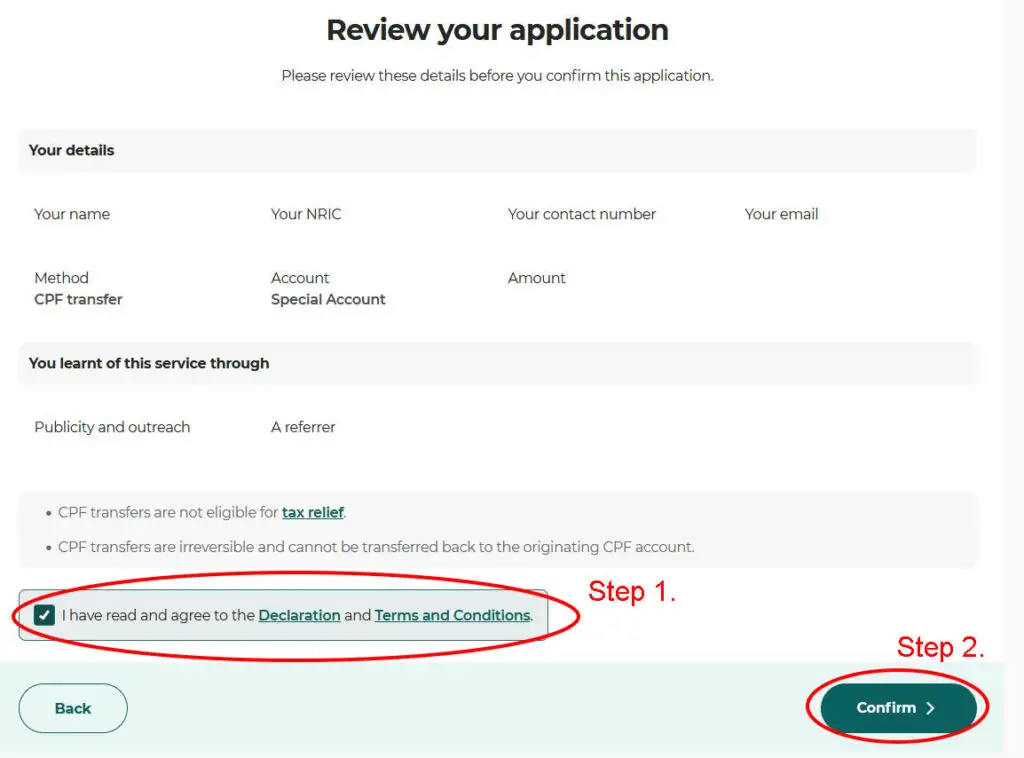
8. Lastly, you will receive an acknowledgement of your transfer. Congratulations, you have transferred your funds from your OA to your SA!
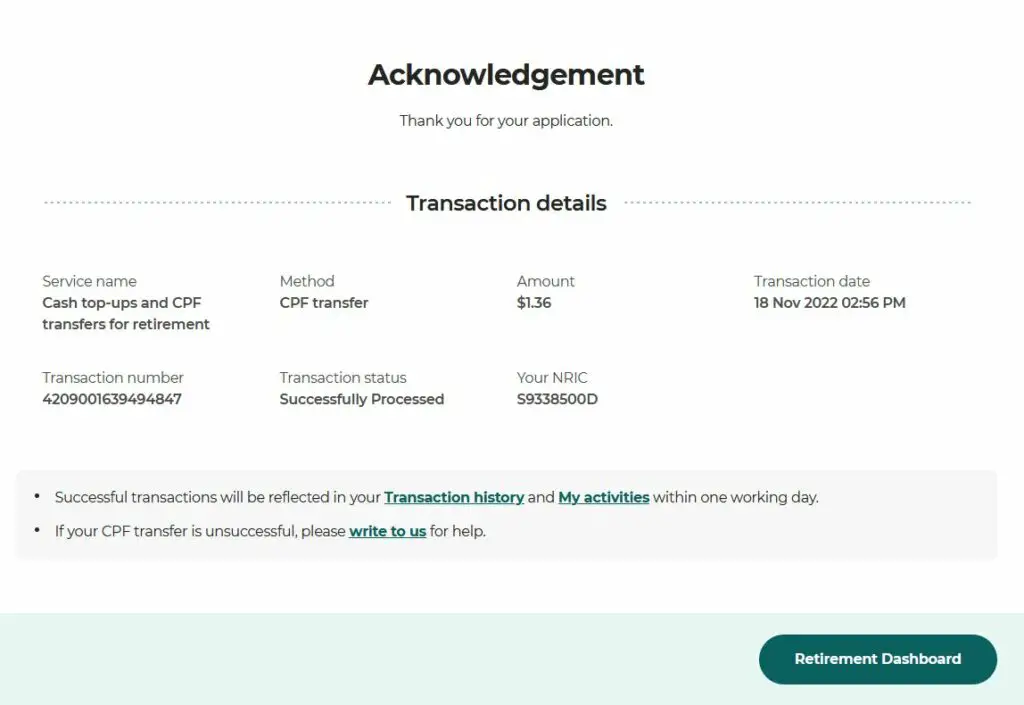
#2 CPF Mobile App
1. After logging into your CPF app using your SingPass, you will be redirected to your dashboard. Scroll down to the “Quick Access” section and select “Top-up or Transfer”.
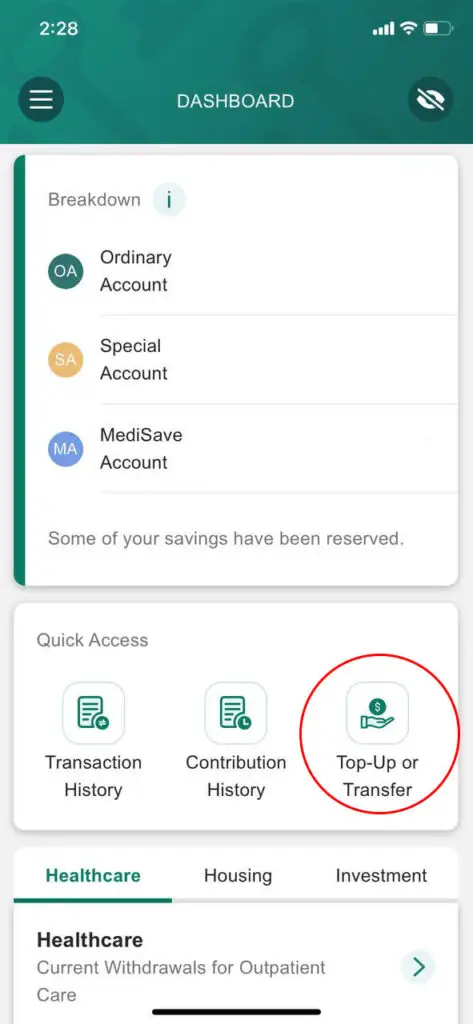
This selection allows you to top up CPF accounts using cash or your CPF monies.
2. Following this, you will be given general information regarding top-ups. Read them carefully and select “Continue” at the bottom to start the top-up process.
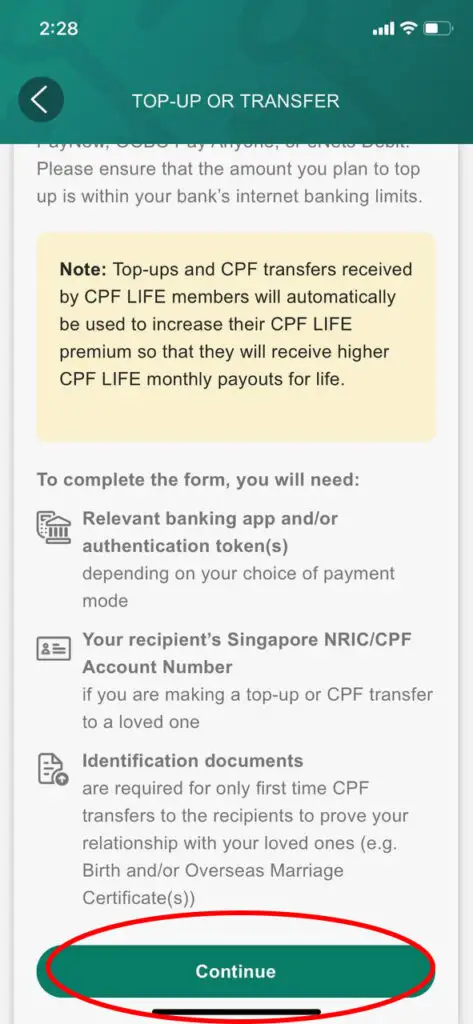
3. On the next page, select “CPF Transfer” as the top-up method, followed by “Self” as the recipient. Scrolling down, enter the amount you want to transfer, then select “Continue”.
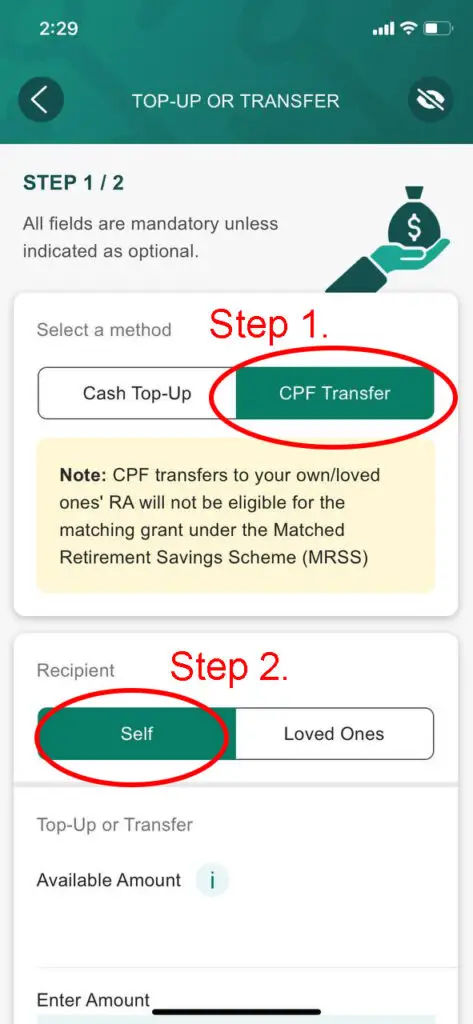
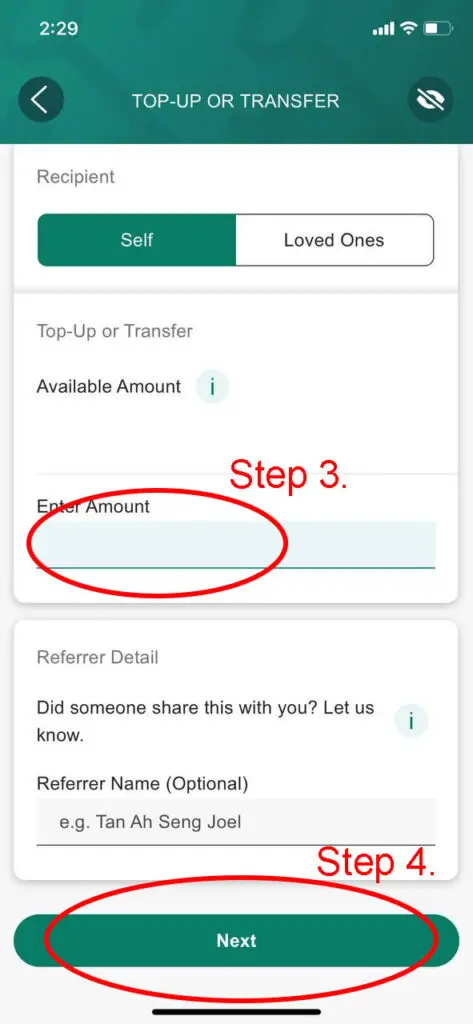
4. You will be then prompted with the Terms and Conditions of the transfer. Read and agree to them before selecting “Next”.
5. On the final step, you will be asked to review your transfer. Once you have confirmed that the details are correct, select “Confirm”.
6. Lastly, you will receive an acknowledgement of your transfer. Congratulations, you have transferred your funds from your OA to your SA!
You can find out whether you should top up your CPF SA or SRS account here.
Can I transfer from my CPF OA to my spouse’s SA?
To enhance your combined CPF returns as a couple, you can transfer funds from your CPF Ordinary Account (OA) to your spouse’s Special Account (SA) if your spouse is below age 55.
If your spouse is aged 55 or above, you can only top up to his or her Retirement Account (RA)!
You may have seen situations, especially in the older generation, where households have a single breadwinner. In this case, the breadwinner’s CPF account will have much more than his/her spouse’s.
In such cases, it is possible to generate more interest in your combined CPF balances by transferring funds from the working spouse’s OA to the non-working spouse’s SA. Also, if your spouse’s combined CPF balance is low, he or she may benefit from extra interest!
You can earn an additional 1% interest on the first $60,000 of your combined CPF balances, capped at $20,000 for your OA.
You may wonder: “This method looks good on paper, but how much more interest will we get?” Fret not, here is an example to illustrate this.
Let’s introduce a hypothetical couple, Mr and Mrs Lim. Mr Lim (aged 54), who is working, has a larger CPF OA balance than Mrs Lim (aged 51), who is a housewife.
Initially, Mr Lim had $100,000 in his CPF OA. Meanwhile, Mrs Lim only had $5,000 in her SA.
The large difference between Mr Lim’s OA and Mrs Lim’s SA makes a top-up more worthwhile.
| Mr Lim | Mrs Lim | Total Interest Earned per year | |
| CPF OA | $100,000 | $20,000 | $3,400 |
| CPF SA | $20,000 | $5,000 | $1,250 |
| Total Balance | $120,000 | $25,000 | $4,650 |
Mr Lim then tops up $40,000 from his OA to Mrs Lim’s SA. As a result, Mr Lim has $60,000 left in his OA, while Mrs Lim’s SA balance increases to $45,000.
As a result of this top-up, we can see that the total interest earned by the Lim couple has increased by $950.
| Mr Lim | Mrs Lim | Total Interest Earned per year | |
| CPF OA | $60,000 | $20,000 | $2,400 |
| CPF SA | $20,000 | $45,000 | $3,200 |
| Total Balance | $120,000 | $25,000 | $5,600 (+ $950) |
By transferring our OA funds to our spouse’s SA, we can enjoy additional interest from both the SA and the spouse’s combined balances!
What is the limit to transfer from my OA to my spouse’s SA?
The limit you can transfer from your CPF Ordinary Account (OA) to your spouse’s Special Account (SA) depends on your age.
Below Age 55
If you are below age 55, you can transfer the remaining sum in your OA after setting aside the current Basic Retirement Sum (BRS) for that year.
The BRS is continually adjusted higher yearly to meet rising costs of living.
Let us take an example of a couple, Richard (aged 51) and Ann (aged 49). After having paid off their outstanding loans on their BTO flat, Richard has a balance of $100,000 in his OA in 2022.
In 2022, the BRS was fixed at $96,000.
Want to know more about the different Retirement Sums in your CPF? Check out this article!
After setting aside the BRS for that year, Richard can only transfer $4,000 to Ann’s SA.
| Richard’s OA Balance | Current BRS (2022) | Amount Richard can transfer to Ann’s SA |
| $100,000 | $96,000 | $100,000- $96,000 = $4,000 |
Age 55 or above
If you are aged 55 or above, you can transfer the remaining sum in your CPF savings after setting aside the current Basic Retirement Sum (BRS) for that year.
This includes savings in your Special Account (SA) and Retirement Account (RA), but not your Medisave Account (MA).
How does this calculation differ from the previous one? Let’s find out!
Rahman (aged 57) wishes to transfer a sum from his CPF savings to his wife Aisiah (aged 54), also in 2022. Below is the profile of his CPF savings.
| Rahman’s OA Balance | Rahman’s SA + RA Balance | Total eligible CPF Balance |
| $100,000 | $300,000 | $100,000 + $300,000 = $400,000 |
After setting the BRS for that year, Rahman can transfer $304,000 to Aisiah’s SA.
| Rahman’s Total CPF Balance | Current BRS (2022) | Amount Rahman can transfer to Aisiah’s SA |
| $400,000 | $96,000 | $400,000 – $96,000 = $304,000 |
Notice how Rahman was able to transfer a larger sum to his spouse even though he has the same OA balance as Richard.
The difference lies in the larger transfer limit given to citizens aged 55 or above, which allows them to transfer their SA and RA savings to their spouse.
What is the limit to transfer from my OA to SA?
If you are below age 55, you can top up your CPF Special Account (SA) through the Retirement Sum Top Up (RSTU) Scheme using either cash or your CPF OA funds. The RSTU Scheme aims to boost the retirement sum for you and your loved ones through voluntary top-ups.
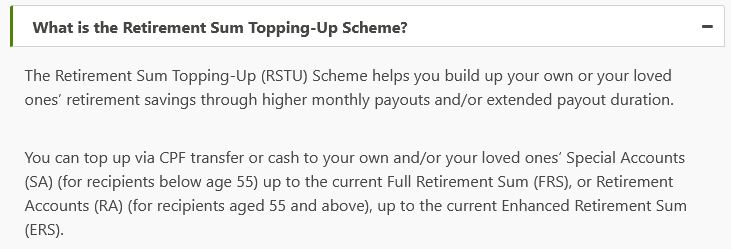
Unfortunately, the RSTU scheme only allows you to top up your RA if you are 55 or above. In this way, the Voluntary Contributions will become the sole way that you can top up your SA.
Apart from your current balance, the top up limit to your SA through the RSTU Scheme depends on 2 factors:
- The Full Retirement Sum (FRS) of the current year
- Savings withdrawn from SA under the CPF Investment Scheme (CPFIS)
Therefore, this is the maximum amount you can top up through the RSTU Scheme:
Max SA Top Up = FRS – SA Balance – Investments from SA
For example, Ravi (aged 42) wants to top up his own SA under the RSTU scheme in 2022. Apart from the balance in his SA, he also has some of his SA funds invested under CPFIA.
This is the profile of his SA:
| Amount | ||
|---|---|---|
| (a) | Current FRS (As of 2021) | $192,000 |
| (b) | SA balance | $151,000 |
| (c) | CPFIA funds withdrawn from SA | $30,000 |
| (d) | Amount that Ravi can top up: (a) – (b) – (c) | $11,000 |
From the above table, we can see that Ravi is only able to top up a maximum of $11,000 through the RSTU Scheme in 2021.
The FRS is continually revised upward every year. Thus, if you have already saved the FRS in your SA, you will need to wait till the revision next year to make further top-ups!
What is the best time to transfer from my OA to SA?
The best time to transfer funds from your CPF Ordinary Account (OA) to your Special Account (SA) will depend on your needs to spend your OA funds.
With your OA funds, you can pay off big proceeds such as your study and housing loans. On the other hand, funds in your SA are strictly for your retirement savings only.
With its long investment horizon, your SA funds are able to command a higher interest rate.
Therefore, to take advantage of both the OA’s liquidity and the higher interest rate of the SA, a good time to transfer funds from your OA to your SA would be after you have paid off any outstanding housing loans using your OA.
As the top-up process from your OA to your SA is irreversible, it would be a good idea to plan your OA spending first before committing them to your SA.
Do I get tax relief if I transfer from my OA to SA?
Unfortunately, any funds transfer from your CPF Ordinary Account (OA) to your Special Account (SA) does not qualify for tax relief.
This is because you can only claim tax reliefs from your CPF contributions from your salary and cash contributions, subject to the CPF Annual Limit.
As of 2022, the CPF Annual Limit stands at $37,740
If you want to enjoy tax reliefs through your CPF top-ups, the best way to do so is by using cash to top up your SA. Using this method, you can save up to $8,000 a year in tax deductions (as of 2022)!
What are the benefits of transferring from my OA to SA?
Transferring funds from your CPF Ordinary Account (OA) to your Special Account (SA) provides benefits for you in the long run. Here are some of them:
Harnessing the power of compound interest
While the CPF OA is a safe haven to save up for your retirement with its stable interest rate, its 2.5% – 3.5% interest per annum leaves more to be desired when investing for long-term goals such as your retirement.
One way to make your excess OA funds work harder for you is to transfer them to your SA, which generates a higher interest of 4 – 5 % per annum.
Excess OA monies refer to your remaining funds after setting aside necessary spending needs such as housing.
Right now, you may wonder: The difference in interest rate is only 1.5%. How much more can I earn in my SA?
To illustrate the effect of a 1.5% difference in returns over time, here is a graph showing the final balance if you had saved the same amount in your OA and SA for 22 years.
By just switching your funds from your OA to your SA, you would have seen a 60% increase in your returns! When comparing the final amounts between both accounts, the SA has 35% more than the OA.
A 1.5% increase in returns may not look much at first, but it can compound much more greatly in the long run.
Keep up with the rising Basic Retirement Sum
Due to the increasing costs of living due to inflation, the government adjusts the Basic Retirement Sum (BRS) of citizens turning 55 every year. In the latest update to this increase in Budget 2022, Deputy Prime Minister Lawerence Wong announced that the BRS will be raised by 3.5% every year until 2027.
The funds in your OA alone are unable to keep up with this increase!
Topping up your SA gives you a guaranteed 4 – 5% interest in your savings, which is more than enough to cover the BRS increases for the next few years. This gives your CPF portfolio greater strength to fight against inflation.
As the funds in your SA go directly to your Retirement Account (RA) when you turn 55, saving more in your SA also means you will be saving up more for your retirement.
With a larger RA fund, you will be able to enjoy larger handouts under CPF LIFE!
Should I transfer from my OA to SA?
If you have excess funds in your CPF Ordinary Account (OA), it would be a good idea to transfer some of them to your Special Account (SA).
While you can use your OA for specific needs such as housing and school loans, you cannot withdraw your OA funds.
As the remaining amount of your OA will eventually be combined with your SA and Medisave Account (MA) to form your Retirement Account at age 55, these funds will eventually end up in your retirement savings. Since we are saving for a long-term goal, transferring your OA funds to the higher-interest rate SA makes financial sense to achieve greater returns.
Therefore, a possible strategy with your OA funds would be to transfer them to your SA as early as possible after setting aside any spending needs in your OA.
Alternatively, consider investing your OA funds to achieve greater returns. Check out this comparison between investing your CPF and SRS funds to see if that is suitable for you!
Conclusion
If you are considering to perform a top-up to your CPF Special Account (SA) with your Ordinary Account (OA), you are not alone! In the first three quarters of 2022, a record sum of $3.5 billion in voluntary top-ups was made to CPF accounts, with cash top-ups and CPF transfers to Special or Retirement Accounts being the most popular method.
While top-ups on your SA with your OA do not get the same recognition as cash top-ups, it is an integral part of a strategy to maximise your Retirement Account (RA) funds.
Therefore, I hope that this guide can give you more insights into OA-SA transfers and how to perform them. Do check out this page for more guides on other topics about your CPF!
You can find out more about the CPF SA in this guide here.

Do you like the content on this blog?
To receive the latest updates, you can follow us on our Telegram channels (Personal Finance or Crypto) and Facebook.
Are you passionate about personal finance and want to earn some flexible income?

